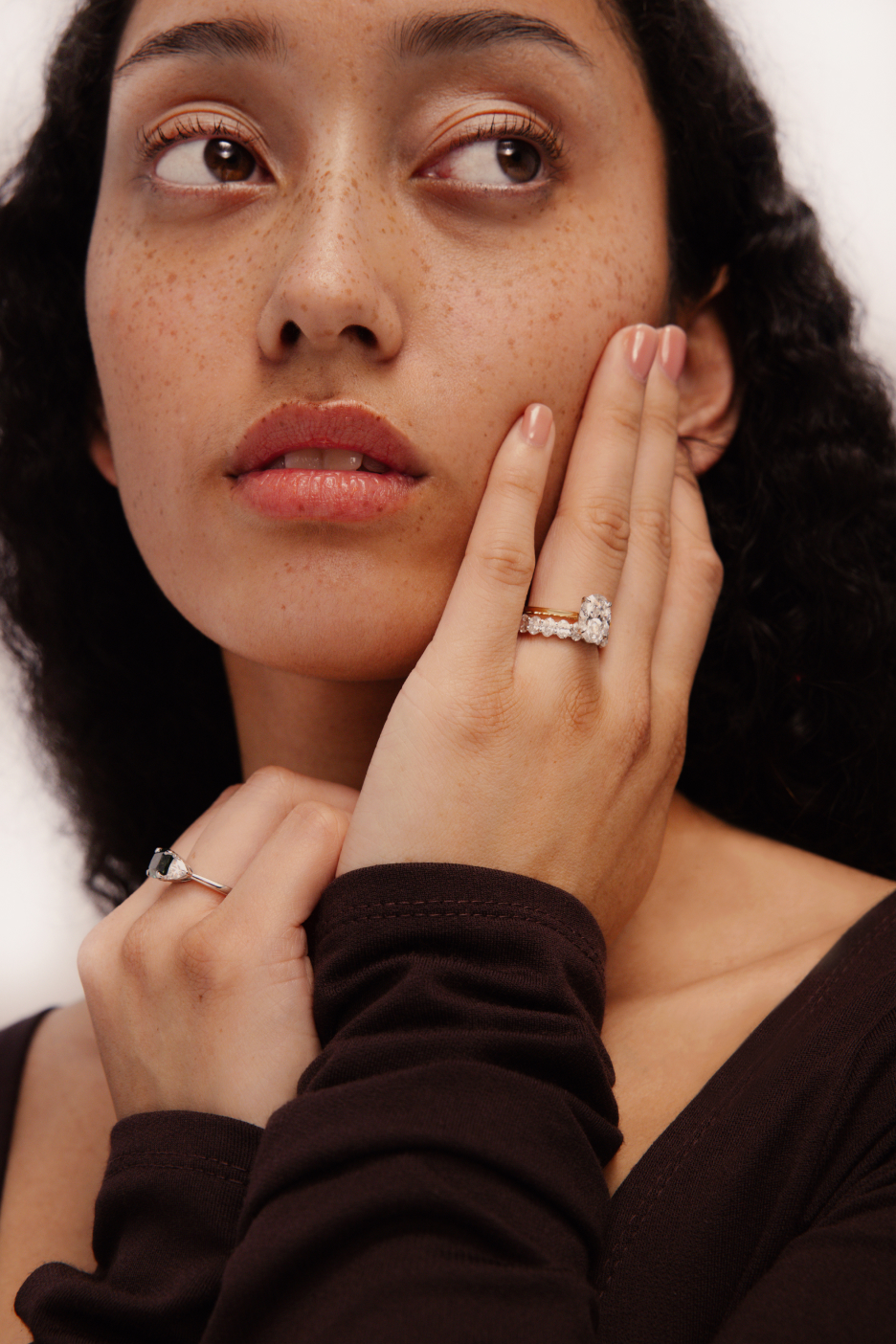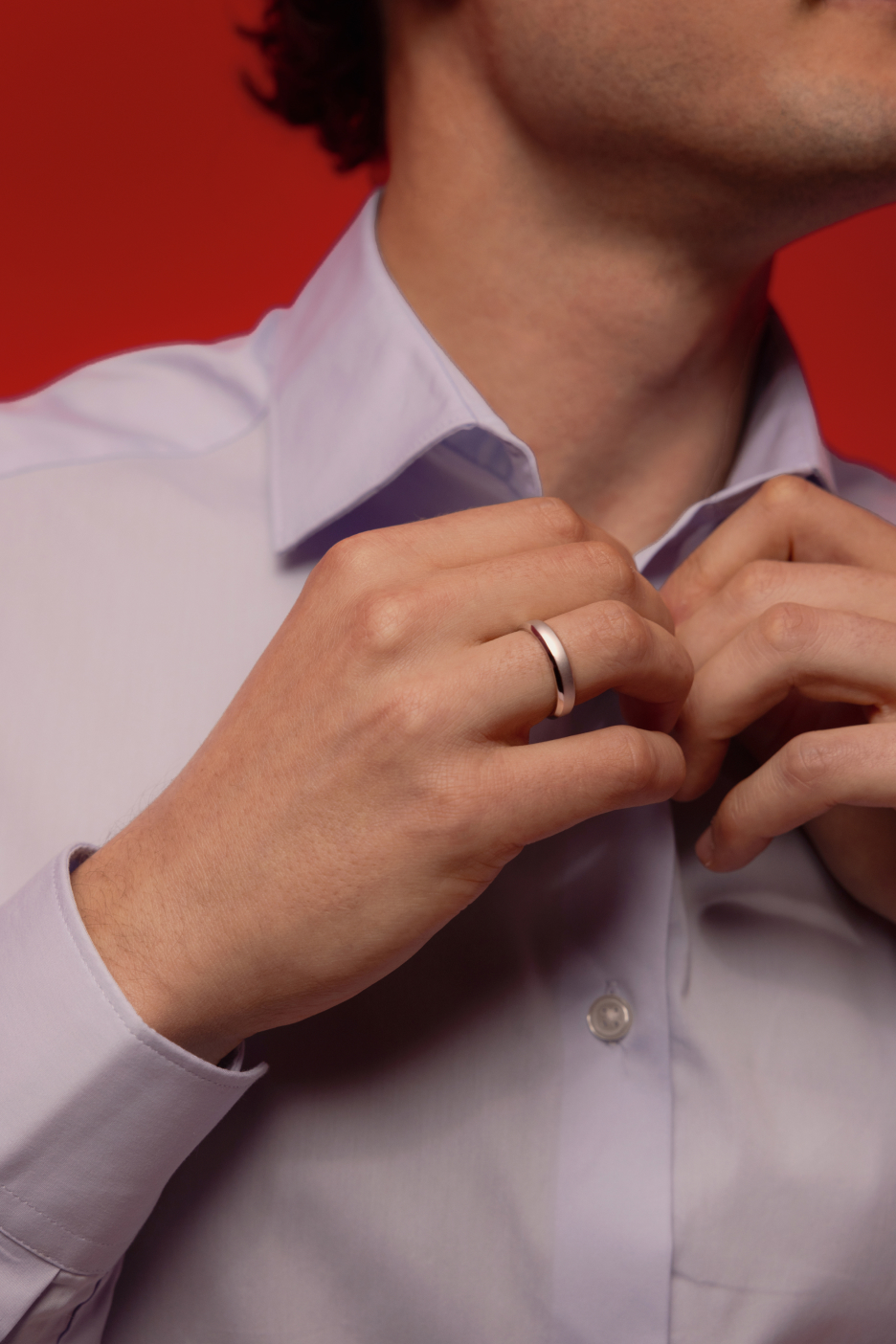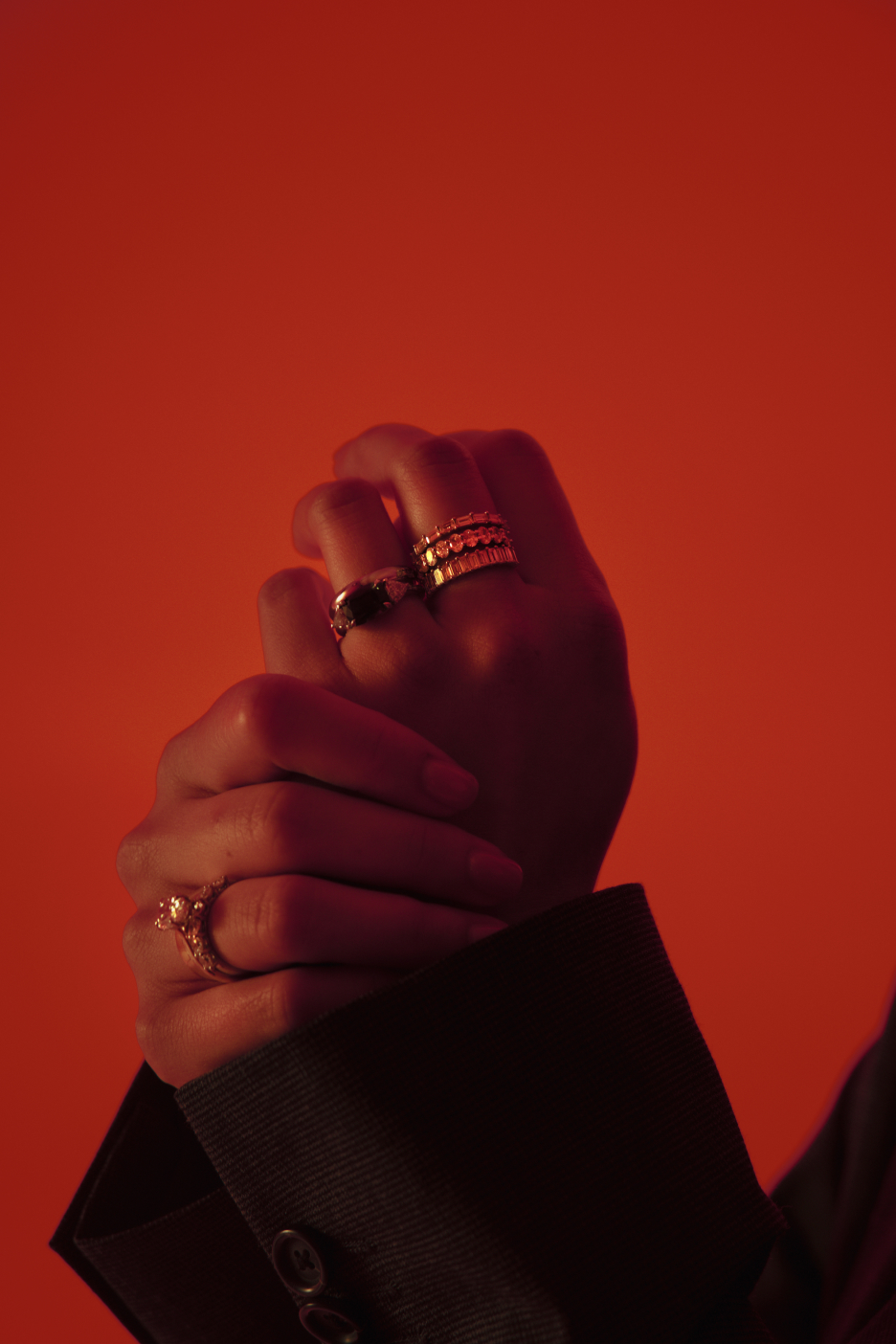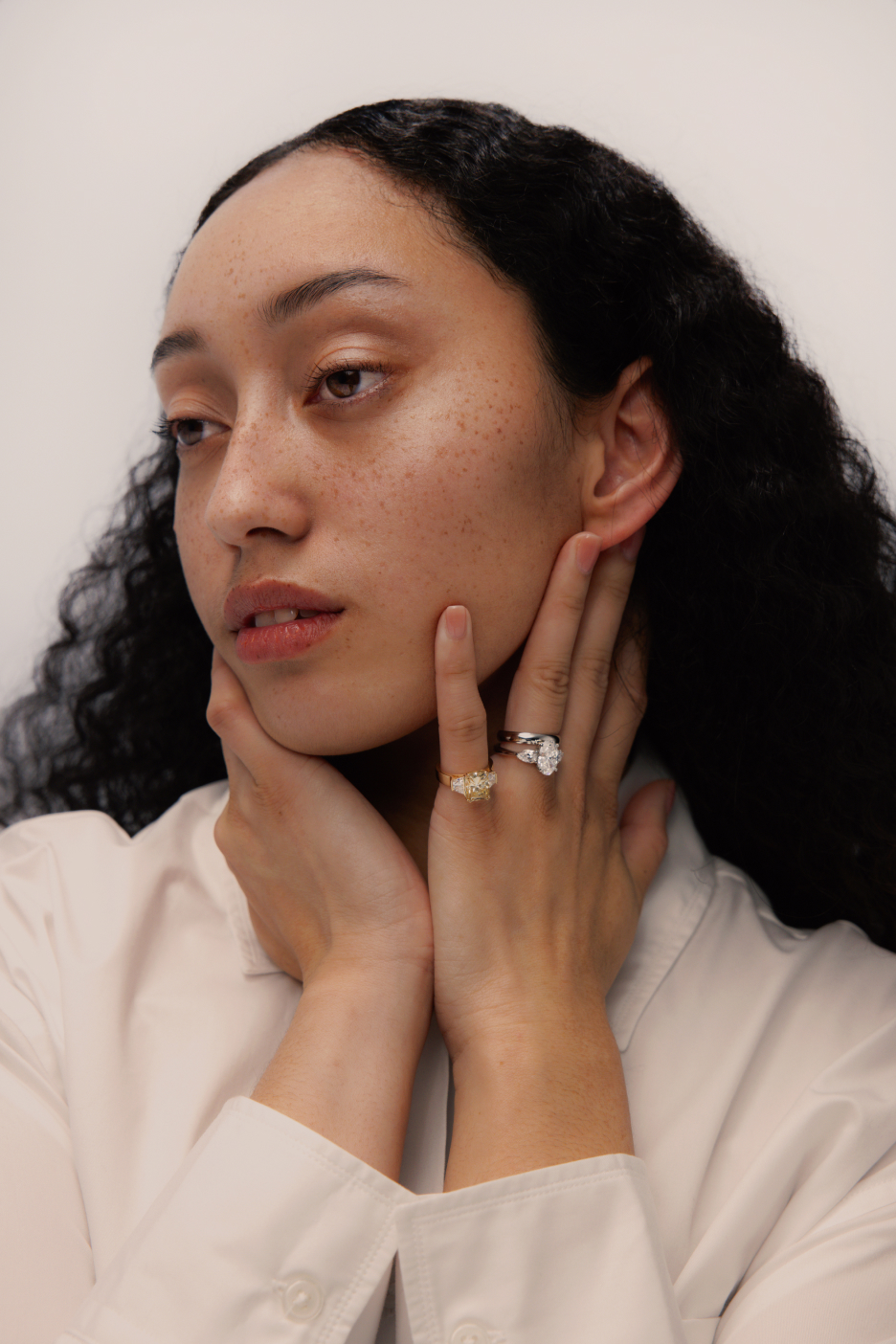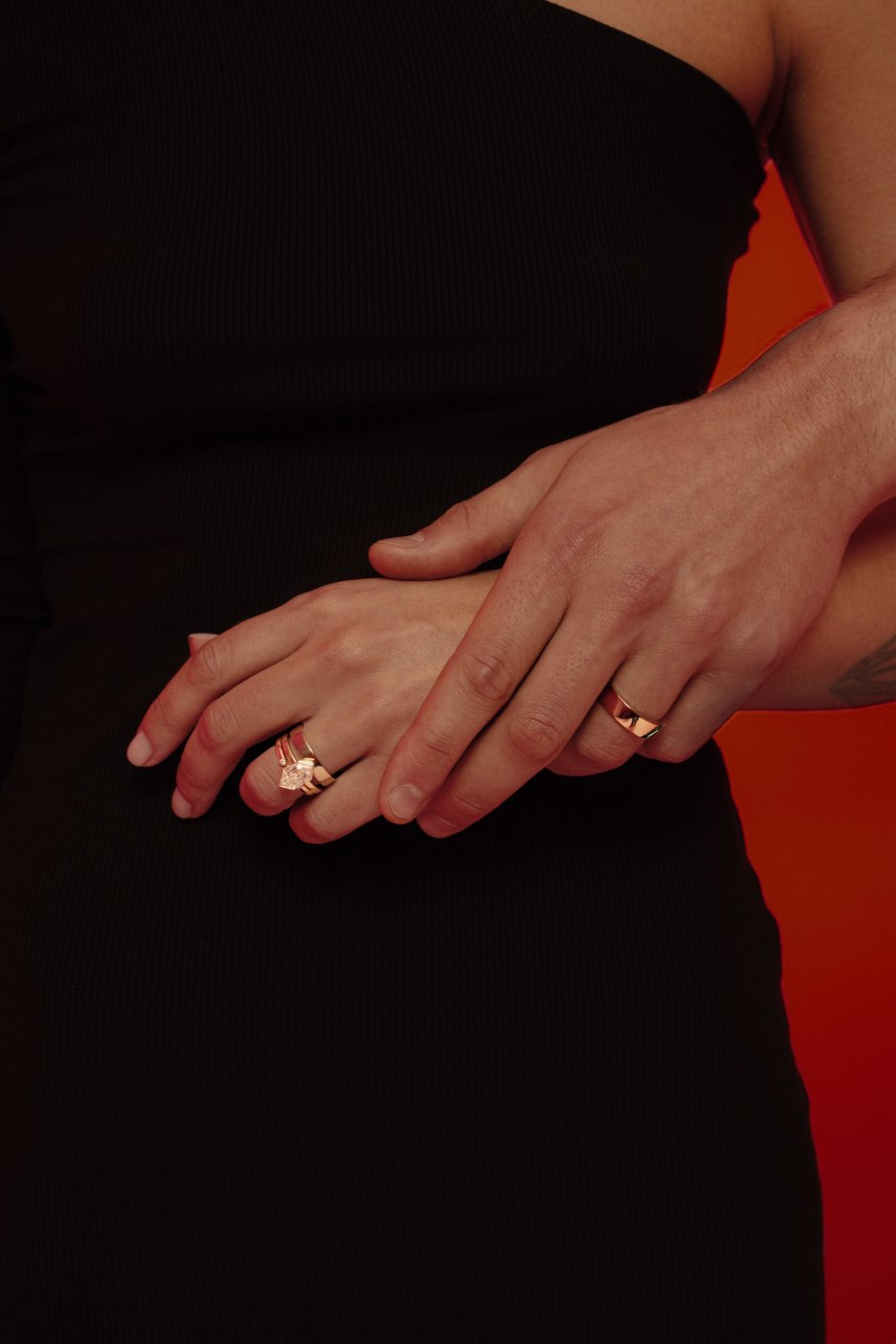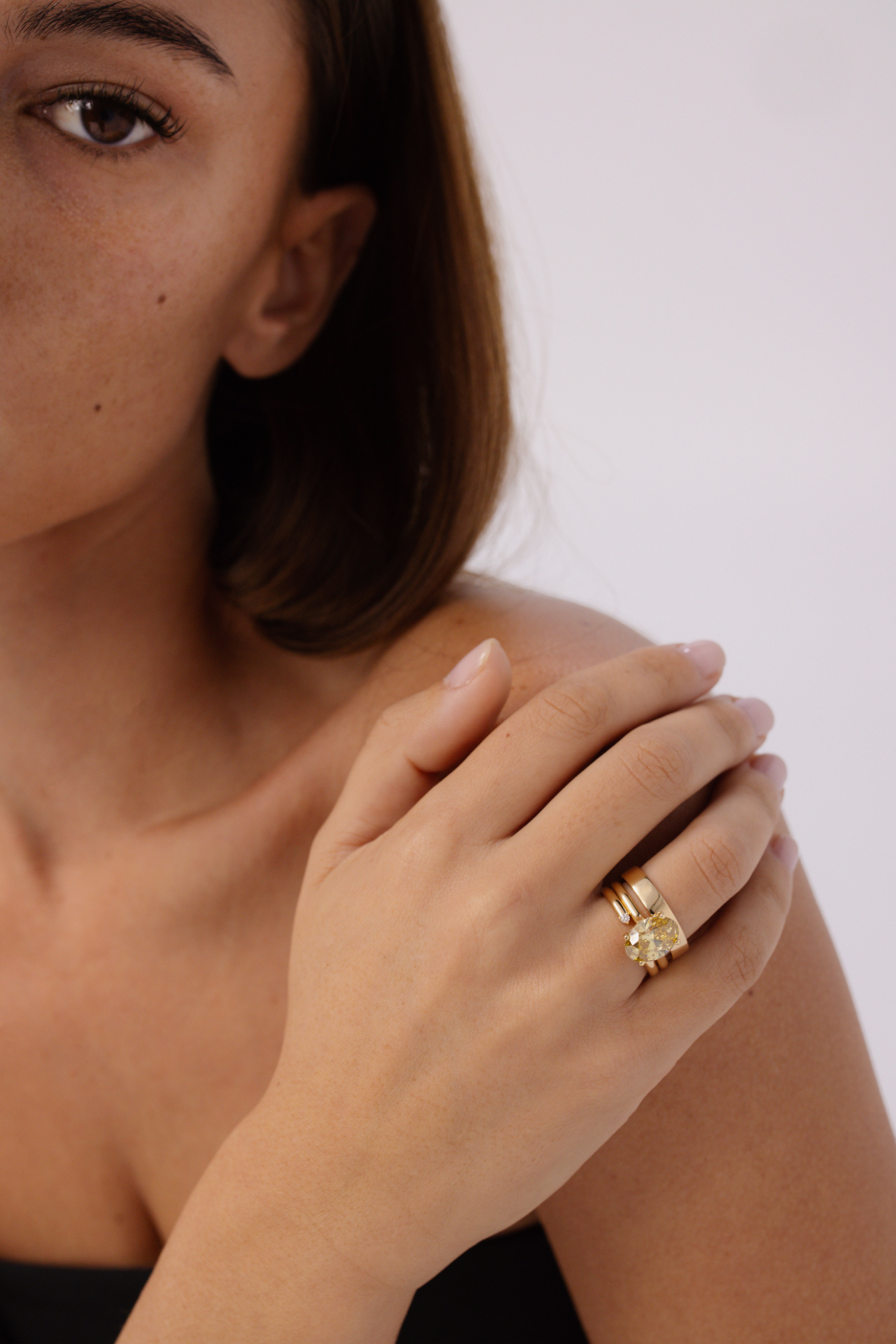How to buy the best solitaire engagement rings

A solitaire engagement ring is the type of engagement ring you most frequently see and probably think about.
This article will provide expert advice on the following:
Choosing your lab grown diamond or gemstone.
Choosing the right shape.
Customising your band.
Adding any additional features for a personal touch.
Let's get started.
What Is A Solitaire Engagement Ring?
A solitaire engagement ring is where there is only one noticeably sized diamond or gemstone. And while there may be other smaller diamonds or gemstones around it, or on the ring itself, the main feature is obvious.
Is A Solitaire Engagement Ring Boring?
Solitaire engagement rings are classic and timeless. They also go with any outfit. However, if you do want to add more personality to your engagement ring, you can do so with an interesting cut (shape), or have diamonds or gemstones on the ring itself.
What Does A Solitaire Engagement Ring Mean?
A solitaire engagement ring symbolises love, affection and commitment between the couple. It can also mean strength, especially when the centre stone is a diamond.
Choosing Your Solitaire Engagement Ring Centre Stone
While diamonds, particularly lab grown diamond engagement rings are the obvious choice, there are other gemstones that are becoming increasingly popular.
Lab grown diamonds
Lab grown diamonds have now become the default option when it comes to an engagement ring. They are physically, optically and even atomically exactly the same as their mined counterpart.
Furthermore, they are much more sustainable than mined diamonds. But most importantly, they are much more affordable than a mined diamond. For example, you can get a 1 carat lab grown diamond round cut solitaire with an ideal cut, DEF colour VS+ starting from around NZD 4000.

Moissanites
Moissanites, for example, look very similar to diamonds and are actually more sparkly. They are also slightly cheaper than lab grown diamonds which means you can get an even bigger stone.
The trouble with moissanites from the other retailers is that they use diamond cutting techniques on moissanites. Moissanites have a different atomic and optical composition so when they are cut like diamonds, they actually appear dull and lifeless.

At Four Words, we work with specialist moissanite cutters that optimise for sparkle. This means that your moissanite will look very similar to a diamond and the only reason that someone will be able to tell the difference is because of its sparkle.
Coloured Gemstones
Coloured gemstones speak to a more modern form of the solitaire engagement ring. And if you are still wanting a diamond or moissanite, they also can come in different colours. The most requested are pink and champagne diamonds, and green moissanites.
Other gemstones that you can consider include sapphires, rubies, emeralds, spinels and alexandrites.
Sapphires
Sapphires are our most popular coloured gemstone because of their extensive range of colour and opacity. This means that in most cases, we can find the exact colour that you are looking for. The most popular sapphire colours are our blue-green sapphires. Teal sapphires in particular have seen a huge surge in popularity in the last 12 months.

Rubies
Rubies are great if you are looking for a rich red coloured engagement ring. They actually belong to the same class of gemstones as sapphires (known as the Corundum group) and also look as stunning. Rubies are less popular as an engagement ring gemstone but if done well, can be a show stopper.

Alexandrites
Alexandrites are a special type of gemstone. They change colour depending on the type of light. Under sunlight they appear as green-blue in ambient light and blue-red under incandescent light. When done well, the alexandrite can be the envy of all your friends, especially with smaller accenting diamonds or moissanites.
At Four Words, we only work with gemstones that we believe will last for the test of time. We also work with ethical labs from around the world to source the gemstone in the colour that you are looking for. In the case that we cannot source the exact colour, we will make recommendations on other gemstones where we can.
Regardless of if you go for a coloured gemstone or not, when you work with Four Words, you will always get the best diamond, moissanite or gemstone that the eye can see. We collectively have more than 20 years of experience in choosing the best gemstones and continue to hone our craft to get you the best without paying high street prices.
Cut (or shape)
The next thing that you need to think about when designing your solitaire engagement ring is the shape of the diamond or gemstone. The most popular cuts are: oval, round, emerald, radiant and the pear cut.
Oval solitaire engagement rings

But not all oval diamonds or moissanites are created equal. And even if you spend a lot of money on a sizeable carat, it won’t mean that you will be the envy of your friends. You need to be particularly weary of the bowtie effect.
The bowtie effect is when a pair of black triangles appear in the centre of your oval diamond or moissanite. This happens because parts of the diamonds don’t reflect light effectively. And when this happens, it shows on the face of the diamond as a darker reflection across the largest facet of the diamond.

The bowtie effect is most pronounced on all elongated cuts of diamonds or moissanites — marquise cut and pear cuts in particular. The most difficult aspect of the bowtie, especially when choosing a diamond is that they do not appear on diamond reports. You can get an excellent cut oval diamond which is flawless and still have a bowtie.
Bowties are inevitable, but they can be minimised. And working with a jeweller like Four Words will help you choose you an oval diamond or moissanite that doesn’t suffer from this to the point that it’s noticeable.
Round brilliant cut engagement rings
Round gemstones is the most classic type of engagement ring. Also known as the Tiffany cut, they are specifically cut for sparkle. As such, their facets should have perfect symmetry. And if it doesn’t, it shows.

There are lots of iterations of the round diamond. Before sophisticated diamond and gemstone cutting techniques, the ‘Old European’ cut was the most popular cut.

And even with the modern round brilliant cut pioneered by Tiffany & Co with its triple excellent standard, a Japanese jeweller came up with an even more perfect cut — known as the Hearts and Arrows round cut diamond. Hearts and Arrows diamonds are cut in a way that eight hearts can be viewed from the bottom of the diamond, and eight arrow shapes can be viewed from the top.
The faceted design of the hearts and arrows diamond is only visible through a special tool called an ASET scope (the red images). Unfortunately this signature cut can’t be detected by the natural eye.

The pattern is also difficult to capture in images once the stone has been set in a ring. For this reason, some consider the Hearts and Arrows effect to be a nice gesture, but one that doesn’t have any practical implications (but it’s still super cool).
Most Ideal cuts and some Excellent cuts will have hearts and arrows but without the official grade. It is in the grading and verification that the cost increases.
When picking our diamonds, we aim to always get you a Hearts and Arrows diamond (even if not officially graded with Hearts & Arrows).

Round cuts do not exclusively come in diamonds and moissanites. They come in all the other gemstones. But here’s the thing.
The round shape is specifically optimised for sparkle and brilliance. And if you are working with colour, then this defeats the purpose. It is much more difficult for colours to sparkle in the way that diamonds and moissanites do. It is for this reason, that if you are going for a round coloured gemstone, then only do so because you like the shape — not because of the sparkle.

Emerald cut engagement rings
The emerald cut is a stepped gemstone and has a rectangular shape which means that it can make your fingers appear slimmer and longer. They also work amazing with accent stones and they look much bigger relative to other cuts of the same carat.

You also get more surface area per carat. This is because of the way that emeralds are cut. They are not maximised for sparkle — instead for their symmetry and stepped facets. Emeralds are a great starting stone if you want to play with colours, an interesting design, or look at a multi-stone engagement ring.

And just like with all the other diamond and gemstone cuts, emerald cuts can’t just be chosen based on the 4Cs. Emeralds are prone to windowing and extinction. This is where poor cut emeralds either leak too much light appearing clear, like a window; or don’t refract enough light and create very dark areas. This affects diamonds and gemstones. You want to avoid emerald cut stone especially, like this.

Also, emerald cut stepped surfaces mean that inclusions and flaws are much more apparent. A slightly included emerald cut diamond, especially near the centre will decrease the visual appeal of the diamond or gemstone overall.
Cushion cut engagement rings
Cushion cuts is a broad term for diamonds and gemstones that have a square-rectangular shape but don’t have stepped cuts. They are typically quite sparkly (but not as sparkly as a round cut) and are becoming increasingly popular. In fact, it went wild on our Instagram.

Cushion cuts are like buying a pillow. There isn’t really a grade or standard and relying on the 4Cs wont be a great idea. It ultimately does come to a matter of taste and seeing the diamond (online or in person). Cushion cuts do not have an official cut grade because there is so much variability. Different length-to-width ratios, faceting patterns to the angles in which the corners are shaped, there are just so many different ways a cushion can be cut. This means that even the shape of a cushion cut can be different. It also means that each cushion cut is unique.
Crushed vs non-crushed cushion cuts
Crushed Ice Cushion cuts have small facets that show little flashes or shimmers of sparkle. As the name suggests, they have features similar to pieces of crushed ice.
We tend not to recommend this style unless a customer explicitly wants one or is trying to incorporate a coloured diamond or gemstone.
This is because, diamond manufacturers intentionally cut Crushed-Ice Cushions to maximise carat weight, rather than trying to maximise light performance (or sparkle). They can lack contrast and sparkle when viewed in a face-up position.
While with coloured stones, this style of cut helps emphasise colour, which can sometimes be lost with a sparkly stone.

Non-crushed ice cushions are specifically cut for sparkle. They have bigger facets meaning on hand, they produce larger flashes resulting in a much better sparkle.

At Four Words, we ensure that you are informed of this before you buy a diamond or gemstone. We do this by showing you the diamond or gemstone and walk you through it before purchasing.
Radiant cut engagement rings
One of the more recently developed cuts (1970s), the radiant cut is known for its brilliant faceting pattern which is a mixture of a kite and star-shaped facets from the centre - outwards. Its used to maximise light reflection — and in most instances is more sparkly than cushion and emerald cuts.
Similar to emeralds, they have their corners angled so they don’t have any 90 degree angles. Furthermore, this is a perfect place to add the prongs to maintain the cushion cut’s rectangular shape.

Unlike emerald cuts, and similar to cushion cuts, radiants come in both square and rectangular shapes, offering versatility to suit your custom bespoke engagement ring needs. Four Words, we can also do custom cut diamonds, moissanites and gemstones so you can get exactly what you want. It also means choosing a radiant simply based on the 4Cs can be very tricky.
At Four Words, we only pick the best diamonds, moissanites and gemstones that the eye can see. Furthermore, what makes a great clear diamond or gemstone wont be for its coloured equivalent. This is why when you work with us, we will spend time to better understand exactly what you are looking for and tailor a solution to your bespoke custom engagement ring.
Pear cut engagement rings
Pear cut engagement rings, or look exactly as the name suggests. They have been growing in popularity in New Zealand and make a great centre stones for solitaire and unique engagement rings.

Pear cuts appear larger than round cuts because they have a larger surface area. They also can make your finger appear longer because of its shape. This is excellent if you have short fingers.
Similar to ovals, pear cut diamonds and clear moissanites also can suffer from the bowtie effect. Bowties are not reported on independent grading certificates. The only way that you can avoid a bowtie is by visually inspecting the diamond. Unless you get a black moissanite that is!

Most jewellers only concentrate on the 4Cs (Cut, Clarity, Colour and Carat). But at Four Words, we take the hassle out of choosing a Pear shaped diamond or gemstone. We check through about 15-20 variables to choose you the best possible diamond or gemstone that the eye can see. This all comes as part of our Four Words standard. We also believe that you shouldn’t pay for things that you can’t see so you get the best diamond or gemstone that the eye can see.
How Do you Make Your Solitaire Engagement Ring More Interesting?
You can use halos, hidden halos, bezels and even add diamonds or gemstones to your band.
Halos and hidden halos
Halos refer to a design feature where the central diamond or gemstone is “surrounded” by smaller gemstones. “Hidden halos” are halos that sit beneath the central gemstone which makes it only visible when viewed from the side.
When traditional halos are diamonds or moissanites, they help to amplify the sparkle of the central gemstone. This is the most common way halos are used.

Hidden halos are a more subtle design consideration and they offer something more personal. They are sleek, don’t risk getting caught on clothing and when working with larger stones, offers a way to speak to something special without overwhelming the central diamond or gemstone, and subsequently appearing gaudy.

Coloured gemstones are popular with hidden halos. The common that we see at Four Words are green moissanites.

Prongs and bezels
Prongs essentially hold your gemstones in place. While functional, they can also be designed in specific ways as part of your custom bespoke solitaire engagement ring.
Number of Prongs – Single or Double
Single prongs
These are individual prongs that hold the diamond or gemstone in place.

Double prongs
Two prongs placed right next to each other offering additional security and its own unique aesthetic

Prong Shape – Pointed or Round
Further, you can customise the style of your prongs. The most common is a pointed or round claw, with both being effective at keeping your diamond secure.
Eagle Claw or Pointed Prongs
This provides an edgier aesthetic, as the points taper towards the center of the ring. One advantage is there is more metal holding diamond or gemstone in place, making it more secure.

Round Prongs
These are minimalist and timeless – this style helps show more of the stone, while still safely securing your diamond or gemstone.

Bezels
A bezel setting in an engagement ring is when a thin piece of metal (typically the same material as your band) wraps around the diamond or gemstone. So instead of having prongs that hold the gemstone, it is the bezel.

Bezels can be both half or full set. While bezels look outstanding with straight cut diamonds or gemstones, they also are functional in protecting the gemstone. So much so, they are often used to protect the points of marquise, hexagonal and pear cut diamonds.


We recommend bezels for those who live an active lifestyle and want to ensure to protect their diamond or gemstone in an elegant way. Bezels also make cleaning your ring a lot easier too.
Customising your band for your solitaire engagement ring
There are three key ways to customise your band for your solitaire engagement ring. This comes down to metal, colour and whether or not it has diamonds on it or not.
Metal
There are four choices you have when it comes to colour and metal:
Yellow gold
At Four Words we typically work with 14 and 18K gold. Anything higher tends to be quite soft.

Rose gold
An alloy with copper, rose gold is typically 75% gold and 25% copper. The exact colour will depend on the proportions of gold and copper. They look great with emerald and Asscher cuts.

White gold
This is the metal-colour combination that we recommend the least. It has a silvery appearance but not an icy finish. It is coated with a thin layer of Rhodium. Over time, this plating wears off leaving a ‘dirty-silver’ look. The good thing is that it can be re-coated. This typically needs to be done every five or so years.

Platinum
If you are looking for an icy white finish — especially if you are using diamonds or moissanites, with a halo, then platinum would be your best bet. It is less likely to scratch than gold and is incredibly sturdy.

Diamonds along the band
Now that we have covered the band colour and metal, you can personalise it with having diamonds running right around the band, or half way down.

For solitaire engagement rings, the typical way to do so is in a pave setting. This is where each small diamond or gemstone is held in place by tiny prongs or beads holding them in place. A pave ring design will mean that the small gemstones are closely set reducing the visibility of the prongs or beads that hold them in place. If you are using diamonds, then this will add a lot more sparkle to your ring overall. And if you are looking for an ice-cool finish, then pave is a great way to amplify that effect.
Buy your dream solitaire engagement ring
Still a bit unsure on your solitaire engagement ring? Reach out to us for an obligation free chat about what you are looking for. At Four Words we do custom bespoke engagement rings so you can design exactly what you want.
